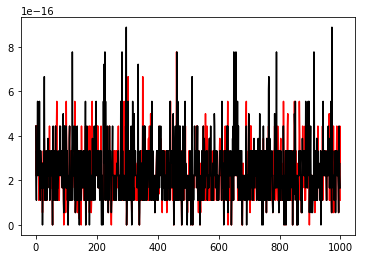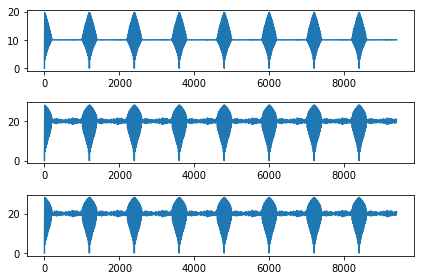Reference link: http://www.cs.unm.edu/~mueen/FastestSimilaritySearch.html
import matplotlib.pyplot as plt
%matplotlib inlineimport pandas as pd
import numpy as np
from numpy.fft import fft, ifft
from scipy.signal import convolve, correlatet=np.linspace(0,10,200)
y=np.sin(2*np.pi*t)
plt.plot(t,y)
x=np.append(y,np.random.rand(1000)*0.1)
for i in range(3):
x=np.append(x,x)
plt.figure()
plt.figure(figsize=(25,5))
plt.plot(x)[<matplotlib.lines.Line2D at 0x7f12a1e83e90>]
<matplotlib.figure.Figure at 0x7f12a3fc8ad0>
Distance vector estimations require you to compute moving averages fast. In MATLAB, we have movmean.
Numpy lacks this function. So, we explore 3 candidate moving average functions:Brute-Force (BF), Pandas based and a faster one that uses uniform_filter1d from scipy.ndimage.filters
from scipy.ndimage.filters import uniform_filter1d
def movmean_bf(x,m):
n=len(x)
movmean=np.zeros(n)
for i in range(n):
last_m_indices=range(i,-1,-1)[0:m+1]
movmean[i]=np.mean(x[last_m_indices])
return movmean
def movmean_pd(A,m):
return pd.Series(A).rolling(window=m+1,min_periods=0).mean().values
def movmean_fast(A,m):
orig=np.int(m/2)
movmean=uniform_filter1d(A.astype(float), m+1, mode='constant', origin=orig)
movmean[0:m]=np.cumsum(A[0:m])/(np.arange(1,m+1)+0.0)
return movmeanA = np.array([4, 8, 6, -1, -2, -3, -1, 3, 4, 5])
M = movmean(A,[2 0])
4.0000 6.0000 6.0000 4.3333 1.0000 -2.0000 -2.0000 -0.3333 2.0000 4.0000
https://www.mathworks.com/help/matlab/ref/movmean.html
A = np.array([4, 8, 6, -1, -2, -3, -1, 3, 4, 5])
m=2
m1=movmean_bf(A,m)
m2=movmean_fast(A,m)
m3=movmean_pd(A,m)
print(m1,m2,m3)(array([ 4. , 6. , 6. , 4.33333333, 1. ,
-2. , -2. , -0.33333333, 2. , 4. ]), array([ 4. , 6. , 6. , 4.33333333, 1. ,
-2. , -2. , -0.33333333, 2. , 4. ]), array([ 4. , 6. , 6. , 4.33333333, 1. ,
-2. , -2. , -0.33333333, 2. , 4. ]))
n_trials=1000
er1=[]
er2=[]
for i in range(n_trials):
n=np.random.randint(3,108)
A=np.random.rand(n)
m=np.random.randint(2,n)
m1=movmean_bf(A,m)
m2=movmean_fast(A,m)
m3=movmean_pd(A,m)
e1=np.abs(m1-m2)
er1.append(np.max(e1))
e2=np.abs(m1-m3)
er2.append(np.max(e2))
print('The max abs deviation-1 was '+str(np.max(er1)))
print('The max abs deviation-2 was '+str(np.max(er2)))
plt.plot(er1,'r')
plt.plot(er2,'k')The max abs deviation-1 was 7.77156117238e-16
The max abs deviation-2 was 8.881784197e-16
[<matplotlib.lines.Line2D at 0x7f12a17fc150>]
n=1000
m=200
A=np.random.rand(n)
%timeit movmean_bf(A,m)
%timeit movmean_fast(A,m)
%timeit movmean_pd(A,m)100 loops, best of 3: 16.4 ms per loop
The slowest run took 4.79 times longer than the fastest. This could mean that an intermediate result is being cached.
100000 loops, best of 3: 15.6 µs per loop
1000 loops, best of 3: 246 µs per loop
from scipy.spatial import distance
def dist_est_BF(x,y):
m = len(y)
n = len(x)
dist=np.zeros(n-m)
for i in range(0,n-m):
dist[i] = distance.euclidean(x[i:i+m],y)
return dist
def dist_est_fast1(x,y):
#x is the data, y is the query
m = len(y)
n = len(x)
# O(n) shit here!
meany = np.mean(y);
sigmay = np.std(y,ddof=0);
meanx = pd.Series(x).rolling(window=m,min_periods=0).mean().values
sigmax = pd.Series(x).rolling(window=m,min_periods=0).std(ddof=0).fillna(0).values
y = y[::-1];#Reverse the query
y = np.pad(y, (0, int(n - len(y)%n)), 'constant')
#FFT: O(n log n) magic!
X = fft(x);
Y = fft(y);
Z = X*Y;
z = ifft(Z)
dist = 2*(m-(z[m-1:n]-m*meanx[m-1:n]*meany)/(sigmax[m-1:n]*sigmay));
return np.sqrt(dist)
def dist_est_fast2(x,y):
#x is the data, y is the query
m = len(y)
n = len(x)
# O(n) shit here!
meany = np.mean(y);
sigmay = np.std(y,ddof=0);
# Running stats
meanx = movmean_fast(x,m+1)
sigmax = pd.Series(x).rolling(window=m,min_periods=0).std(ddof=0).fillna(0).values
y = y[::-1];#Reverse the query
y = np.pad(y, (0, int(n - len(y)%n)), 'constant')
#FFT: O(n log n) magic!
X = fft(x);
Y = fft(y);
Z = X*Y;
z = ifft(Z)
dist = 2*(m-(z[m-1:n]-m*meanx[m-1:n]*meany)/(sigmax[m-1:n]*sigmay));
return np.sqrt(dist)
d1=dist_est_BF(x,y)
d2=dist_est_fast1(x,y)
d3=dist_est_fast2(x,y)
plt.subplot(311)
plt.plot(d1)
plt.subplot(312)
plt.plot(d2)
plt.subplot(313)
plt.plot(d3)
plt.tight_layout()
#############
%timeit dist_est_BF(x,y)
%timeit dist_est_fast1(x,y)
%timeit dist_est_fast2(x,y)/m2/shared/env/local/lib/python2.7/site-packages/numpy/core/numeric.py:531: ComplexWarning: Casting complex values to real discards the imaginary part
return array(a, dtype, copy=False, order=order)
10 loops, best of 3: 98.3 ms per loop
100 loops, best of 3: 2.01 ms per loop
1000 loops, best of 3: 1.67 ms per loop



